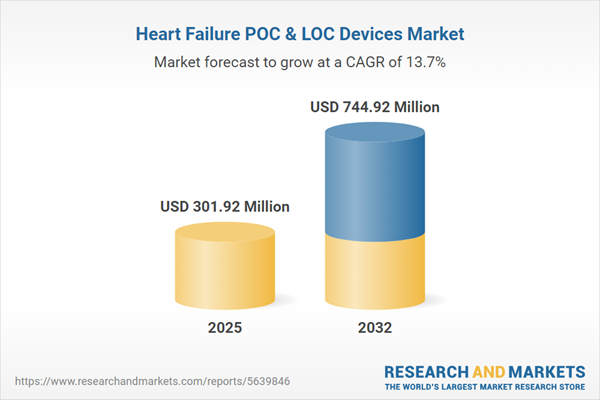Speak directly to the analyst to clarify any post sales queries you may have.
The Heart Failure POC & LOC Devices Market is advancing rapidly as innovations in diagnostic technologies reshape patient management strategies. As healthcare systems prioritize accurate, decentralized, and timely diagnostics, senior stakeholders must evaluate evolving solutions and competitive dynamics influencing growth and operational resilience.
Market Snapshot: Heart Failure POC & LOC Devices Market
The Heart Failure POC & LOC Devices Market grew from USD 267.11 million in 2024 to USD 301.92 million in 2025. It is expected to continue growing at a CAGR of 13.67%, reaching USD 744.92 million by 2032. This growth reflects sustained investment in decentralized diagnostics, the impact of regulatory shifts, and rising demand for actionable, near-patient testing capabilities.
Scope & Segmentation
- Test Type: Genomic Testing, Metabolomic Testing, Proteomic Testing.
- Device Type: Cardiac Biomarker Analyzers, Cardiac Imaging Devices, Electrocardiograms (ECG), External Defibrillator, Heart Rate Monitors.
- Technology: Biosensor-based systems, Imaging & impedance-based platforms, Immunoassays, Nucleic acid-based platforms.
- End User: Assisted Living Healthcare, Home Care Facilities, Hospitals & Clinics, Laboratory.
- Region: Americas (United States, Canada, Mexico, Brazil, Argentina, Chile, Colombia, Peru), Europe, Middle East & Africa (United Kingdom, Germany, France, Russia, Italy, Spain, Netherlands, Sweden, Poland, Switzerland, United Arab Emirates, Saudi Arabia, Qatar, Turkey, Israel, South Africa, Nigeria, Egypt, Kenya), Asia-Pacific (China, India, Japan, Australia, South Korea, Indonesia, Thailand, Malaysia, Singapore, Taiwan).
- Company Coverage: Abbott Laboratories, ACON Laboratories Inc., Becton, Dickinson and Company, Bio-Rad Laboratories, Inc., bioMérieux S.A., Boston Scientific Corporation, Cipla Limited, Danaher Corporation, F. Hoffmann-La Roche Ltd., Fukuda Denshi Co., Ltd., Jant Pharmacal Corporation, Johari Digital India Limited by Syrma SGS, Koninklijke Philips N.V., LifeSign LLC, LifeSync, Luminex Corporation by DiaSorin S.p.A., Mitsubishi Chemical Group Corporation, Nexus Dx, Inc, Nihon Kohden Corporation, Quidel Corporation, Schiller AG, Shenzhen EDAN Instrument Co., Ltd., Shenzhen Mindray Bio-Medical Electronics Co., Ltd., Siemens Healthineers AG, Spectral Diagnostics Inc., Trinity Biotech PLC.
Key Takeaways
- Decentralized, point-of-care, and lab-on-chip diagnostics are enabling earlier detection and more tailored management for heart failure, especially outside traditional hospital environments.
- Technological advancements, such as microfluidics and biosensor integration, are driving laboratory-grade performance in compact, patient-friendly formats.
- Healthcare providers are prioritizing solutions that support predictive analytics, data connectivity, and real-time patient insight, accelerating digital health implementation.
- Supply chain and sourcing strategies are adapting in response to regulatory and economic shifts, emphasizing agility and risk mitigation.
- Cross-industry alliances between device manufacturers, technology firms, and providers are fostering innovation cycles and accelerating product validation.
- Device adoption remains highly dependent on infrastructure, reimbursement, and regulatory maturity within each regional market.
Tariff Impact
Recent U.S. tariffs have increased costs for imported device components, prompting companies to reconsider supplier networks, nearshoring options, and inventory strategies. These changes are fostering tighter collaboration across the value chain and introducing new procurement models focused on resilience and flexibility. Downstream, buyers are restructuring contracts to account for fluctuating tariffs and currency shifts.
Methodology & Data Sources
This analysis employs a robust methodology, combining extensive secondary research from peer-reviewed sources, regulatory filings, patent databases, and corporate data. Primary interviews with industry experts, decision-makers, and clinicians complement these findings. Quantitative results are validated through triangulation and industry-informed frameworks, ensuring accuracy and relevance for senior leaders.
Why This Report Matters
- Supports strategic investment and product decisions with validated market intelligence on heart failure diagnostic trends and supply chain developments.
- Enables precise segmentation for technology adoption, region-specific opportunities, and competitor benchmarking.
- Delivers actionable insights for decision-makers focused on future-proofing operations amid evolving regulatory and economic pressures.
Conclusion
Senior executives will find this report a critical tool for navigating the shifting heart failure diagnostics landscape. With detailed segmentation, analysis of technology and regional trends, and strategic guidance, it empowers teams to identify growth pathways, strengthen partnerships, and sustain operational excellence.
Additional Product Information:
- Purchase of this report includes 1 year online access with quarterly updates.
- This report can be updated on request. Please contact our Customer Experience team using the Ask a Question widget on our website.
Table of Contents
3. Executive Summary
4. Market Overview
7. Cumulative Impact of Artificial Intelligence 2025
Companies Mentioned
The companies profiled in this Heart Failure POC & LOC Devices market report include:- Abbott Laboratories
- ACON Laboratories Inc.
- Becton, Dickinson and Company
- Bio-Rad Laboratories, Inc.
- bioMérieux S.A.
- Boston Scientific Corporation
- Cipla Limited
- Danaher Corporation
- F. Hoffmann-La Roche Ltd.
- Fukuda Denshi Co., Ltd.
- Jant Pharmacal Corporation
- Johari Digital India Limited by Syrma SGS
- Koninklijke Philips N.V.
- LifeSign LLC
- LifeSync
- Luminex Corporation by DiaSorin S.p.A.
- Mitsubishi Chemical Group Corporation
- Nexus Dx, Inc
- Nihon Kohden Corporation
- Quidel Corporation
- Schiller AG
- Shenzhen EDAN Instrument Co., Ltd.
- Shenzhen Mindray Bio-Medical Electronics Co., Ltd.
- Siemens Healthineers AG
- Spectral Diagnostics Inc.
- Trinity Biotech PLC
Table Information
| Report Attribute | Details |
|---|---|
| No. of Pages | 192 |
| Published | November 2025 |
| Forecast Period | 2025 - 2032 |
| Estimated Market Value ( USD | $ 301.92 Million |
| Forecasted Market Value ( USD | $ 744.92 Million |
| Compound Annual Growth Rate | 13.6% |
| Regions Covered | Global |
| No. of Companies Mentioned | 27 |









